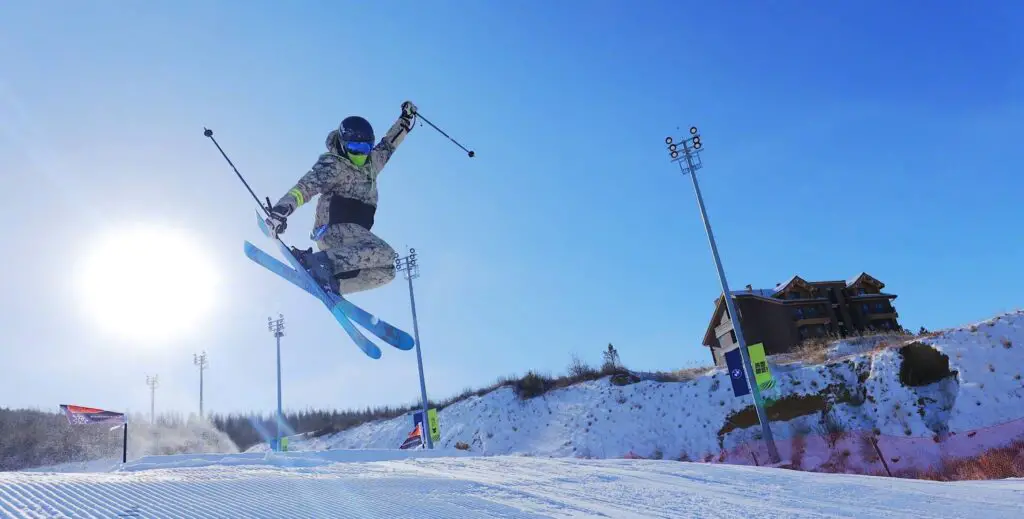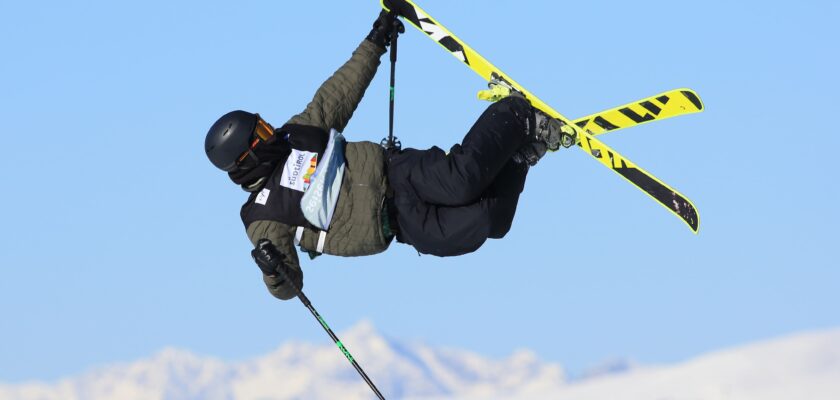Freestyle skiing is a category of skiing that stands out for its acrobatic jumps and fast descents in mountainous terrain. Now it’s time to explore all about freestyle skiing. Shall we?
Open your account at Betano and get up to 1,000 reais in bonuses.
Payments via PIX, live games and super odds!
Click here to open your account!
All about Freestyle Skiing: what is it?
Freestyle skiing comprises six main disciplines. Aerials focuses exclusively on jumping.
In the Moguls and Dual Moguls, in addition to the jumps, skiers face a ramp full of small mounds of snow; in the Dual Moguls, two skiers compete simultaneously.
Slopestyle and Ski Cross involve descents on long slopes with various obstacles. Halfpipe is a channel reminiscent of skateboarding and snowboarding.

Continue reading and learn all about freestyle skiing!
All about Freestyle Skiing: history
Freestyle skiing has been practiced since the 1930s, and its popularity continues to grow. The first competitions in the United States took place in the early 1960s;
In 1979, the International Ski Federation (FIS) recognized freestyle skiing as an official sport, establishing specific rules, athlete certification and safety standards to manage risks during competitions.
The first World Cup of the sport took place in 1980, followed by the first World Championship in 1986;
The Aerials was introduced as a demonstration sport at the Winter Olympics in 1988, and in 1994, it became part of the official program.
Read on and find out all about freestyle skiing!
The moguls was included in the Olympic program in Albertville 1992, while ski cross made its debut as an Olympic event in Vancouver 2010;
The halfpipe and slopestyle were added to the Olympic Games at Sochi 2014, and the Big Air made its first appearance at the Beijing 2022 Games.
Brazil’s participation in official freestyle skiing competitions began in 2009, with Sergio Schuler competing in ski cross at the Europa Cup.
In 2011, Bruno Monti represented Brazil in his first World Freestyle Ski Championship;
The debut of the slopestyl and with a Brazilian athlete was with Lucas Vianna at the 2013 World Championships.
That same year, the CBDN started an Aerials program, selecting Lais Souza and Joselane dos Santos as its first athletes;
Read on and find out all about freestyle skiing!
After a period of training in acrobatics on skis, they competed in the European Cup, North American Cup and World Cup, managing to qualify for the 2014 Olympic Games.
Brazil stood out as the first South American country to host official freestyle equestrian competitions, with the first ski cross event held in Chapelco, Argentina, in 2010;
The first World Cup of the sport in South America was also organized by Brazil, a slopestyle event in Ushuaia, Argentina, in 2012, in which 56 athletes took part.
Read on and find out all about freestyle skiing!
All about Freestyle Skiing: modalities
Freestyle skiing is structured into six Olympic disciplines, with categories for men and women: moguls, aerials, ski cross, halfpipe, slopestyle and big air;
These disciplines are notable for their intense acrobatic component!
Moguls (MO)
The skiers go down a steep slope, full of moguls (small mounds of snow) and jumps for acrobatics. The aim is to complete the course in the shortest time possible, while being judged on their technique in the turns and maneuvers. Victory goes to whoever achieves the highest score for jumps, spins and time in the final round.
Aerials (AE)
The competition focuses on acrobatic jumps, judged on the degree of difficulty, height, precision and execution. The event takes place on two inclined planes. The score for each jump is divided into three criteria: air, form and landing. In general, athletes perform two jumps in the qualifying rounds and two in the final.
Ski Cross (SX)
It consists of a descent on a hilly track equipped with bends, jumps, banks, rollers, U-tangs and other obstacles. In the qualifying phase, the athletes descend individually and are ranked by time. In the final phase, the heats are formed based on the qualifying ranking, and the athletes compete in groups of four, where the two best advance to the final.
Halfpipe (HP)
The race takes place on a U-shaped track, 100 to 170 meters long, where the athletes perform maneuvers that are evaluated. Victory is determined by the best score or a combination of scores.
Slopestyle (SS)
Athletes race down a track up to 800m long, full of jumps and obstacles such as handrails, bunkers and quarterpipes. The score is given for the best maneuver or the sum of the scores for the descents. Unlike the HP, the judges evaluate the maneuvers using similar criteria to the halfpipe.
Big Air (BA)
It consists of two or more descents on a mega ramp after an acceleration ramp, where each descent involves a maneuver of great amplitude and visual impact. The winner is decided on the basis of the best maneuver or the combination of the scores of two or more jumps.
Continue reading and learn all about freestyle skiing!
All about Freestyle Skiing: rules and regulations
If it’s free, does it have rules? Of course there are! Check out more details on the rules and regulations of freestyle skiing below.
Equipment
Skiers must use equipment approved by the International Ski Federation (FIS), which includes skis, boots and poles specific to each sport;
The equipment must meet the safety and performance standards set by FIS.
Clothes
The clothes must be suitable for the sport, providing freedom of movement and safety. In some sports, there are specific requirements regarding the type and color of clothing.
Judgment
The competitions are judged by a panel of judges who assess various aspects of the performances, such as technique, the difficulty of the maneuvers, the amplitude of the jumps and the overall execution;
Grades are awarded on the basis of specific criteria for each modality.
Continue reading and learn all about freestyle skiing!
Security
Skiers must follow strict safety regulations, including wearing helmets and checking their equipment before the competition;
The tracks are also prepared to minimize risks, with obstacles and conditions suitable for each sport.
Ranking and points
In events such as the World Cup and World Championships, skiers accumulate points in each competition, which contribute to their overall ranking for the season or championship.
Continue reading and learn all about freestyle skiing!
All about Freestyle Skiing: main events and athletes
Due to the diversity of its events, it doesn’t have athletes with a history of dominance in every race;
The only skier to win more than two Olympic medals is Norway’s Kari Traa, who won gold, silver and bronze in the Moguls.
Main events
Winter Olympics: Included in the program since 1992 with the Moguls discipline, Aerials was added in 1994 and Ski Cross in 2010. The Halfpipe and Slopestyle events made their debut in 2014.
World Championship: held since 1986, it includes all six disciplines and is currently held in odd-numbered years.
World Cup: Promoted annually since 1980, it is divided into several stages, awarding points to each skier in each race, rewarding those who accumulate the most points overall.
Continue reading and learn all about freestyle skiing!
All about Freestyle Skiing: curiosities
- Brazil’s presence in freestyle skiing at the Olympic Games is exclusively female, with Josi Santos competing in the aerials at Sochi 2014 and Sabrina Cass in the moguls at Beijing 2022.
- Sabrina, before representing the United States, her father’s country, won the world junior title in the moguls.
- In keeping with Brazil’s tradition in winter sports, freestyle skiing also has brothers representing the country, such as Sebastian and Dominic Bowler. They also dedicate their free time to cliff jumping.
Did you already know all about freestyle skiing or have you just learned with us? You might also like:



